- Poison Ivy Plant Facts -
Plant Identification, Ivy Control, and Rash Treatment
The poison ivy plant is responsible for ruining many camping trips and outdoor vacations. Every year millions of people are exposed to this toxic plant after touching or brushing up against it.
To those who are susceptible, allergic reactions can range from mild redness and itching to a severe rash with blistering and oozing sores. Some cases have required a hospital visit while itching and redness can last for weeks.
What Makes the Poison Ivy Plant So Toxic
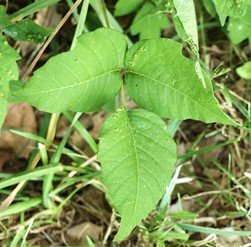
The culprit is a chemical in the sap called urushiol (you-ROO-shee-ol). This chemical is found in every part of the plant, including the leaves, flowers, stems, roots, and even in the smoke when the plant is burned. Contact can result in severe itching, rashes, blistering and oozing, and even infection. Breathing in the smoke of burning ivy will introduce you to a brand new level of discomfort that may put you to the hospital.
Researchers are looking to see if poison ivy is actually becoming more potent. Many believe it is, which is not good news if it is true. This will make it even more important to be able to instantly identify the top three poisonous plants. You will have much more freedom when you can positively identify poison ivy, poison oak, and poison sumac.
Interestingly enough, only humans seem to be allergic to the toxic sap. (Well, hamsters might be allergic too.) Most other animals, including dogs and cats display no reaction. However, pets that come in contact with the ivy can easily transfer it to humans.
Poison ivy can grow in many different conditions and climate zones. It can tolerate wet river bottoms, shaded forests, full sun locations, and even home lawns. It grows well into Canada and throughout much of the U.S.
You are left with a couple basic choices: Never leave the pavement or learn to accurately identify and avoid poison ivy. In cases where it is growing on your property, you should learn how to safely control it along with its cousins, poison oak and poison sumac.
Common Sense Precautions in Ivy Hot Spots
"Leaves of three, let it be" is the popular expression that holds true. There are also harmless plants that look similar, but those who are highly allergic should exercise caution and avoid any plant that looks like it. It is always wise to error on the side of caution.
However, since most people admit they cannot positively identify a poison ivy plant, they can only guess at where the plants might have been growing. Therefore, it is extremely important to be able to instantly identify it.
Poison Ivy Identification
Ivy leaf Characteristics
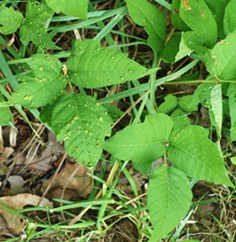
Poison ivy plant leaves always occurs in sets of three. Mature leaves can be 5 inches and almost as wide. They are arranged with two leaves positioned behind a front leaf that emerges from the center of the other two. The front leaf of the poison ivy plant is attached to the stem by a petiole that is about a quarter the length of the leaf itself. (A petiole is the stem part of a leaf that connects to the main stem or vine)
The two back leaves are attached to the main stem by very short petioles and point in opposite directions like the wings on a plane. All three petioles emerge from the stem at the same place.
The photo above are of young plants with 2 inch leaves. They were found growing near a 4 ft. tall poison ivy plant with 4 to 5 inch leaves.
Identification can be more difficult since the leaves are not always shaped exactly the same. All poison ivy leaves are somewhat oval shaped, being widest near the base and coming to a point at the tip. However, the leaf edges may be smooth or they could be saw-toothed.
It is also common for leaves to have one or more lobes, often on just one side of the leaf, but can be on both sides. Generally, if one leaf has a lobe, then the other two will also be lobed.
Depending on where you live, in the fall, the ivy foliage may be yellow, orange, or red. Remember that you can still have an allergic reaction after the leaves have fallen because even the bare stem will secrete urushiol oil. The oil amounts are somewhat reduced in the winter and are the highest in the spring with new growth.
Flowers and Fruit
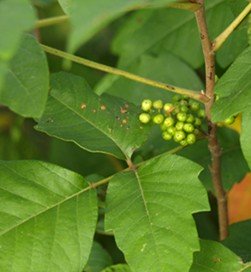
Flowers are difficult to see and are easily missed. They form along the stem between sets of leaves or where petioles connect to the stem. The tiny flowers arise on multiple short stems in clusters of 6 or more. The flowers produce small light green berries that turn a shade of gray or white by summer’s end. These berries can remain on the vine well into the winter after the leaves have fallen. These waxy berries attract birds and other wildlife.
Poison Ivy Stems
Poison Ivy can take three basic forms.
- They can grow as an erect standing, woody stemmed shrub.
- Long creeping vines or stems that run along the ground.
- A fuzzy climbing vine that attaches securely to trees, walls, or fences.
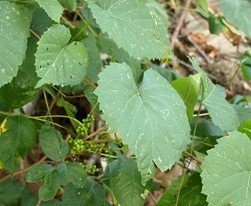
As a climbing vine it will have hundreds of hair-like roots the length of the vine. These fibrous roots hold the ivy firmly to the vertical surface. Since the stems contain urushiol oil, you should be careful grabbing the stems with your hands. To remove them without using your hands, you should cut the stem at ground level with a long-handled lopper and gently grab the stem with the cutting end of the pruning equipment and pull it off the tree.
Poison ivy plants can be masters of disguise. The photo above shows a poison ivy plant growing under a kudzu plant. The berries are easily seen. The vines of the poison ivy plant are extending out and wrapping around and following along the kudzu vine making it difficult to see.
Ivy Roots
Poison ivy has a fibrous root system. The stems will root where they make soil contact. Due to this rooting ability, even if the stems are cut at ground level, the poison ivy plant will continue to grow as long as it has rooted farther down the stem. This makes the plant more persistent and difficult to control. After heavy rains it is usually easier to pull the entire vine from the ground. Pieces of root left behind in the soil can regenerate into new plants, so care should be taken to remove them all.
Chemical Controls for Poison Ivy
There are several products labeled for control of poison ivy plants.
Herbicides Containing Glyphosate
One recommended chemical is Glyphosate, the active ingredient of Round-Up, Rodeo, Touchdown, etc. These products are "non-selective", which means it will kill all the weeds and grass it touches. Do not spary these products on any grass or plants you want to keep.
A drawback is that glyphosate does not work as well on woody stemmed plants. Therefore, mature poison ivy plants may not be controlled as well as young plants.
For mature poison ivy with thick woody stems see the herbicide below for the best control method.
Herbicides Containing Triclopry for Mature Woody-Stemmed Plants
Products that work best on mature ivy with woody stems will contain the chemical "triclopyr". Look for products such as BrushMaster, Brush-B-Gon, or other products labeled for brush or woody-stemmed plants.
Buying Tip: Farm and feed stores often carry "Farm and Range Land" Brush and Weed Control Products. The amount triclopyr the product contains will determine if it will only kill small woody stemmed weeds or if it will kill tall heavy brush. The label will indicate the type of weeds or brush it will control.
Be aware that many of these herbicides are not labeled for home use. Some are labeled for use only on non-food producing farms, parks, summer camps, schools, highways, etc. The front of the label will usually indicate where it can be used and who can use it, so check the label carefully.
Real Life Story: I was recently on an organic lawn care and gardening blog and a lady was talking about her severe reactions with poison ivy and was afraid to get near it. However, she discovered some plants on her property that had to go because her kids have severe reactions, as well.
She was asking about chemicals to control the ivy instead of taking the chance on pulling the plants and getting a reaction. The response on the blog was "don't use chemicals, just take your chances with the ivy and remove it by hand." I am amazed how people have so little compassion and are so willing to gamble with other people's health.
In my opinion, there are reasons to use chemicals as a last resort. Some reactions to poison ivy plants are extremely severe and take weeks to heal. The final decision is yours, but if you decide to use chemicals, follow the label exactly and wear all the person protection equipment (PPE) listed on the label.
Allergic Reactions and Treatment
Fortunately, not everyone is allergic to poison ivy plants. While some people may never develop a reaction there are no guarantees. An allergic response can begin at any point in your life after an exposure.
Almost very part of the poison ivy plant contains urushiol oil. When the plant is cut, scratched, crushed, bent, etc. the colorless oil quickly seeps from the wound. When the plant is damaged by animals, such as deer feeding on leaves, stepping on the plant, etc. oil spreads across the damaged surface waiting for you to pass by. The oil can potentially remain active for several months.
The urushiol oil will penetrate the skin in less than five minutes. The first time a person comes in contact with the toxic oil will often not result in any reaction. However, the second time can result in a rash because of antibodies that were created after the first exposure. Allergic reactions usually begin in 8 to 36 hours after exposure.
Be Prepared When in Poison Ivy Plant Areas
If you are severely allergic always apply a pre-exposure "Ivy Block" lotion whenever you are in suspected ivy areas. Keep in mind that in areas with a heavy poison ivy plant infestation, the ivy blocks probably won't work well.
Also bring calamine lotion, Ivarest Maxium Strength, or similar products to be applied as soon as symptoms appear. Some people claim that acne lotions and skin cleansers designed to dry pores and remove skin oils work well. The acne cleanser removes surface oil and dries the infected area. A doctor can prescribe medications if you are not getting relief from over the counter products.
The rash begins with redness and intense itching. Oozing blisters frequently follow. The rash will not heal until it begins to dry up. Infections have been known to set in around the wet, oozing sores, especially with intense scratching. Consult a doctor if it becomes infected. It frequently takes two to three weeks for the rash to heal.
A Home Remedy for Poison Ivy
Taking a hot shower is one remedy that is doctor recommended after exposure to poison ivy plants.
Here is the Catch
Heat from the shower water releases a chemical in the body called Histamine. Histamine is the substance that makes your skin itch. Initially, the hot shower will make you skin itch even more. However, the trick is to slowly increase the temperature of the shower water as hot as you can take it. (Don't burn yourself)
You must stay in the shower until the itching stops. After several minutes the cells will have released and depleted all their stored histamine. You will have relief from itching for several hours until more histamine can be produced.
If you can't do this, a cool shower offers some relief as well, but will not last as long as a hot shower.
Is poison Ivy Contagious?
This is a question that is asked quite often. In short, the answer is no. Here are some common beliefs.
- Some people believe that just being near the plant, but not actually touching it, is enough to get an allergic reaction.
- Some believe that once the rash has begun, the rash can spread over much of the body.
- Some believe that you can have an allergic reaction to poison ivy simply by being in the same room with someone who has it.
Are the above situations true? No, but if you are a skeptic, then it may help to look at it like this.
The poison ivy rash is much like a sunburn. You will only get a sunburn on your body where the sun has actually touched and burned the skin. With a poison ivy rash, it is much the same. The oil from the ivy must touch the skin at the place where the rash occurs before a reaction can begin. If you have a rash at any point on your body it is because some oil was on the skin at that location.
As soon as the oil is absorbed into the skin it will not spread any more. Liquid inside blisters, should they break open, do not contain urushiol and will not spread the rash. However, oil on your clothes or on another person's clothing could be transferred onto you.
The oil does not float through the air. The only way the oil can become airborn is from burning the poison ivy plants. The urushiol easily rises with the smoke.
Tips for Reducing the Severity of the Rash
If the oil is washed off quickly after exposure, reactions may be less severe or prevented altogether. Wash in free flowing water, such as a faucet, stream, or hose. If there is no flowing water, fill a bucket from a pond or puddle and repeatedly pour water over your exposed body parts. Washing up to thirty minutes after initial exposure using soap and cold water is thought to lessen the severity of the rash.
After exposure, change you clothes quickly so oil doesn’t penetrate your clothing and get on your skin. Water is thought by some to neutralize the oil. After removing your clothes, spray them with a water hose to help neutralize the oil. Use disposable gloves if there is a need to handle the clothes before washing. Spray your gloves with water before removing them. Do not reuse gloves.
Dogs are immune to the affects of poison ivy, but dogs can easily transfer the oil to furniture, carpets, clothing, etc. Many people who say they have no idea where they came in contact with the plant may have gotten it from their pets.
Do not burn plants that have been removed. Urushoil oil is easily carried with the smoke and can be breathed in. The oil can collect internally in the breathing passages causing severe reactions that will likely require medical attention.
Pictures of Poison Oak and Poison Summac for Comparision
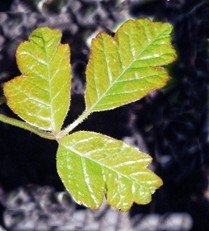
Poison oak is similar to the poison ivy plant, except the leaves resemble white oak leaves. Poison oak usually has rounded lobes, where poison ivy lobes are usually pointed. Poison oak is usually a woody stemmed plant. Young plants are often mistaken for oak trees. The range of poison oak is not as wide as poison ivy.
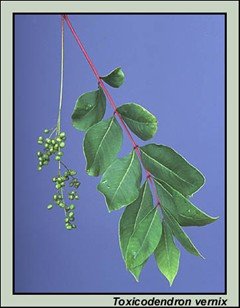
While harmless summac plants are common, poison summac is not that common. Only poison summac causes problems. Chance are that if you encounter a summac plant it will be a non-poisonous type. Poison summac grows in damp locations along river banks, river bottoms, and shady hillsides. The plant is found in the eastern U.S. from Texas to Florida and north into Canada.
The summac plant that most closey resembles poison summac is Winged Summac, a harmless species.
Kudzu Plant Information and Control
Kudzu is an fast growing and aggressive plant that covers everything in its path. Nothing of off limits as it covers fields, fences, trees, and even whole houses. Find out its uses, as well as, how to stop this vine.
Nimblewill Grassy Weed
Nimblewill is grassy weed that resembles bermudagrass. It is most prominent when growing in cool season grasses. Find information on this plant identification, growth habits, and control methods.
Poison Ivy Plant back to Lawn Care Academy Home



